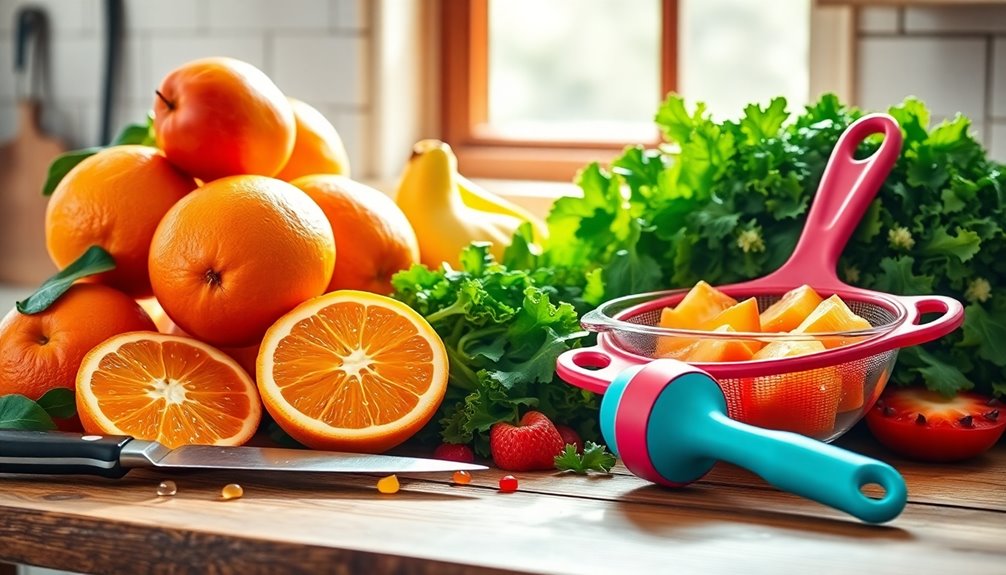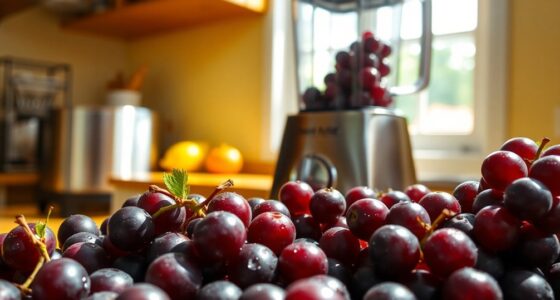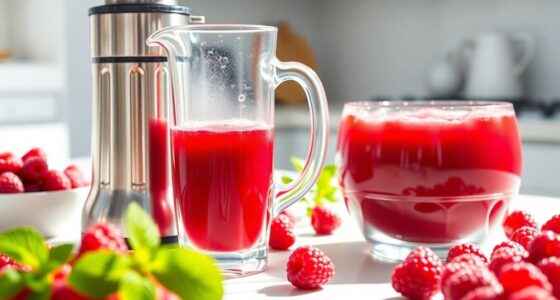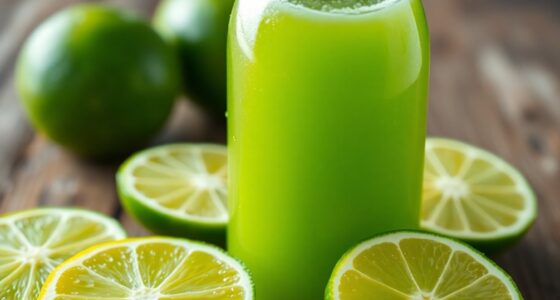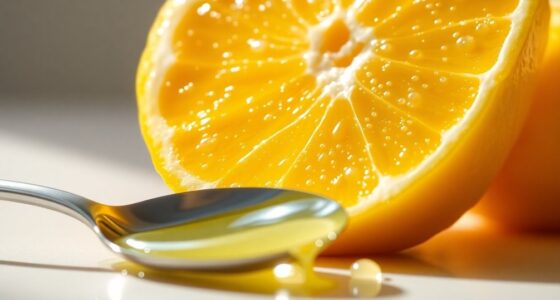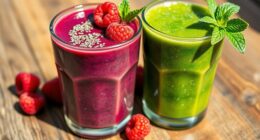You can easily make juice without a juicer by blending your favorite fruits and vegetables, like carrots and oranges. Start by chopping them into smaller pieces and adding a little water to help the blending process. Blend on high until smooth, then strain the mixture with a fine mesh strainer or nut milk bag to separate the juice from the pulp. Store your freshly made juice in a mason jar, and enjoy the vibrant flavors while exploring more tips and tricks! If you’re curious about how to juice a grapefruit, simply slice the fruit in half and use a fork to twist and press the flesh, extracting every last drop of juice. Alternatively, you can use a handheld citrus juicer for a more efficient extraction. Remember to adjust the sweetness of your juice by adding honey or a sweeter fruit if desired, creating a delightful blend that suits your taste.
Key Takeaways
- Select ripe fruits and vegetables, like carrots and oranges, for maximum flavor and nutrition before starting the process.
- Chop ingredients into smaller pieces and blend with a little water to create a smooth mixture.
- Blend on high for about 60 seconds, ensuring a consistent texture for effective straining.
- Strain the blended mixture using a fine mesh strainer or nut milk bag to extract juice, pressing down to maximize yield.
- Store the juice in a mason jar in the refrigerator, where it lasts up to 3-4 days while retaining its nutritional benefits.
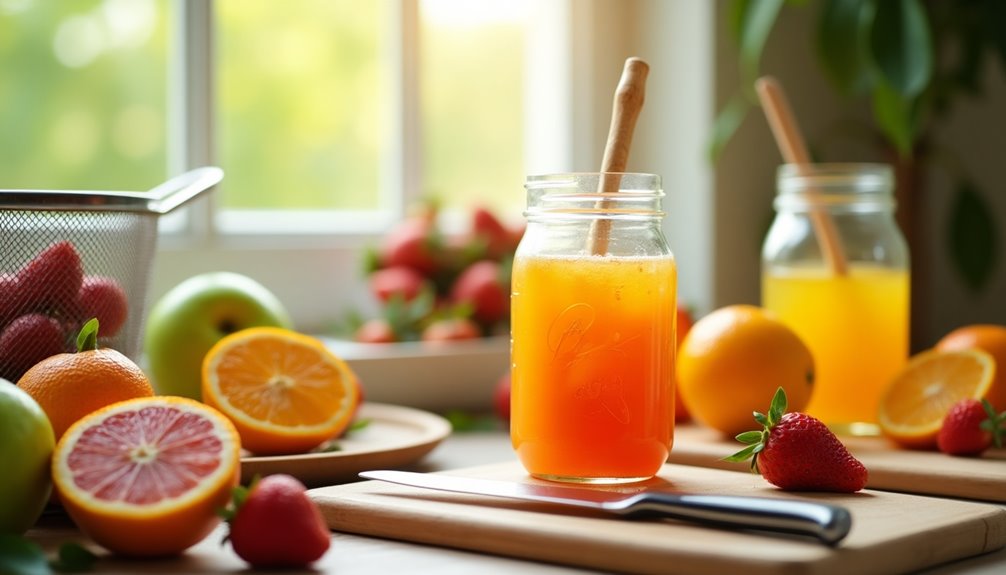
Making juice without a juicer might seem challenging, but it's actually quite simple and rewarding. You don't need fancy equipment to enjoy delicious homemade juice packed with nutrients. With just a small blender and a few ingredients, you can whip up fresh juice that's bursting with flavor.
Start by selecting your favorite fruits and vegetables—think vibrant carrots, zesty oranges, or invigorating ginger. The combinations are endless, and experimenting can lead you to discover your signature blend.
To get started, gather your ingredients and chop them into smaller pieces. This makes it easier for your blender to process them. Next, add your chopped fruits or vegetables to the blender along with a bit of liquid, like water. This liquid not only helps the blending process but also ensures your juice isn't too thick.
Blend on high for about 60 seconds until the mixture is smooth and well incorporated. You want to achieve a consistent texture, which will make the straining process more effective.
Once you've blended your ingredients, it's time to strain the mixture. This step is crucial if you want to remove the pulp and enjoy a smoother juice. Grab a fine mesh strainer or a nut milk bag, and place it over a bowl or a large mason jar.
Pour the blended mixture into the strainer, allowing the juice to flow through while the pulp gets left behind. You might want to use a spoon to press down on the mixture, extracting as much juice as possible. The result is a refreshing, pulp-free juice that you can enjoy right away or store fresh for later.
If you're wondering how long you can keep your homemade juice, it's best to store it in a mason jar in the refrigerator. Fresh juice can last up to 3-4 days, retaining its nutritional benefits and delicious taste. Just remember to give it a good shake before drinking, as the ingredients may settle over time.
In terms of nutrition, making juice without a juicer allows you to customize your creations. You can easily incorporate vitamin C-rich fruits like oranges or nutrient-dense veggies like spinach and kale.
These nutritious juices can be a fantastic way to boost your immune system and energize your day.
Frequently Asked Questions
What Can I Use if I Don't Have a Juicer?
If you don't have a juicer, you can use a small blender instead.
Start by chopping your fruits and vegetables into smaller pieces for easier blending. Blend them with a little water until smooth, then strain the mixture using a fine-mesh sieve or a nut milk bag to remove the pulp.
This way, you'll get a refreshing juice. Plus, don't forget to repurpose the leftover pulp for added fiber in other dishes!
Can I Use My Blender to Juice?
Yes, you can definitely use your blender to juice! Just chop your fruits and veggies into smaller pieces, then blend them with some water until smooth.
This helps extract the juice effectively. After blending, strain the mixture through a fine-mesh sieve or nut milk bag to get rid of the pulp and enjoy a smooth, refreshing drink.
It's a cost-effective way to enjoy fresh juice without needing any specialized equipment!
How Can I Make Juice Fast Without a Juicer?
When life hands you fresh fruits and veggies, don't let a lack of a juicer slow you down!
To whip up juice quickly, chop your ingredients into small pieces and toss them in a blender with filtered water. Blend until smooth, then strain through a fine-mesh sieve or nut milk bag.
Squeeze out every drop, capturing that liquid gold, and store any leftovers in a mason jar for a refreshing treat later.
How Do You Strain Juice Without a Juicer?
To strain juice without a juicer, you can use a fine-mesh sieve or a nut milk bag.
First, blend your ingredients until smooth.
If you're using a sieve, place it over a bowl and pour the mixture in, letting the juice flow through while the pulp stays behind.
With a nut milk bag, fold it over a pitcher, pour in the juice, and squeeze to extract liquid.
Don't forget to use the leftover pulp creatively!
Conclusion
Making juice without a juicer is easier than you might think! With just a few simple tools and a little creativity, you can enjoy fresh, delicious juice right at home. Whether you're blending, mashing, or squeezing, you'll be amazed at the vibrant flavors you can create. So grab your favorite fruits and vegetables, and unleash your inner juice guru! It's like having a juice bar in your kitchen—minus the long lines and hefty prices!
Cindy thoroughly researches juicing trends, techniques, and recipes to provide readers with practical advice and inspiration. Her writing style is accessible, engaging, and designed to make complex concepts easy to understand. Cindy’s dedication to promoting the advantages of juicing shines through her work, empowering readers to make positive changes in their lives through the simple act of juicing.

